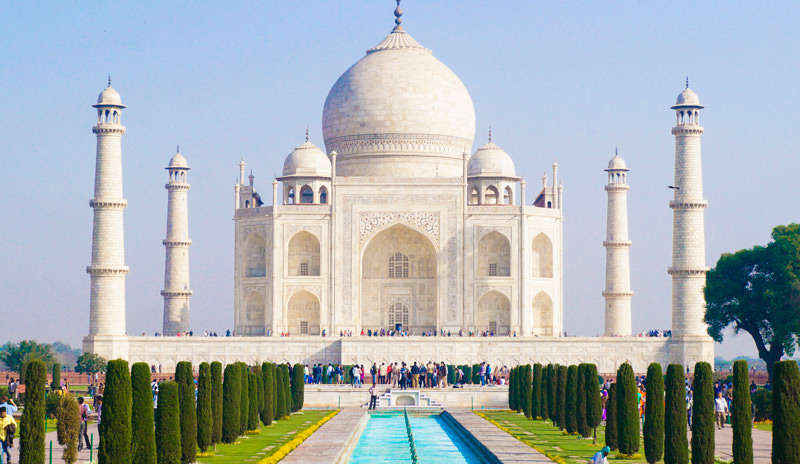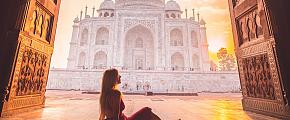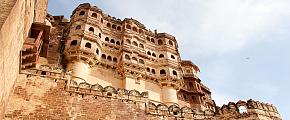Travel Tips in India: Ultimate Suggestions for First-Timers
What do you think of when it comes to vacationing in India? Tropical views, religious atmosphere, busy streets, rich spices, or colorful festivals? Facing these contrasting scenes, beginners may feel excited and a little overwhelmed. It doesn't matter. This article will provide you with some practical travel tips for India to help you easily integrate into this wonderful country.
Best Places to Visit
Here's a list of India's classic attractions, letting you have a primary understanding of India.
Natural Scenery | Cultural Relics |
| -Shimla: The Himalayas -Jaiselmer: Thar Desert -Ranthambore: Ranthambore National Park -Varanasi: the Ganges River -Goa: Beaches -Kerala: Backwaters -Munnar: Tea Plantations | -Delhi: Qutub Minar, Jama Masjid -Agra: Taj Mahal, Agra Fort -Jaipur: Hawa Mahal, Amber Fort, Jantar Mantar -Mumbai: Gateway of India, Victoria Terminus, Dhobi Ghat -Maharashtra: Ajanta Caves, Ellora Caves -Thanjavur: Brihadeeswarar Temple -Kochi: Fort Kochi, Dutch Palace -Madurai: Meenakshi Temple |
Itineraries for Your Choice
Classic Trip: Visit the iconic buildings of the Golden Triangle (Delhi, Agra, and Jaipur) to get a quick overview of India.
Romantic Trip: Explore the Taj Mahal and enjoy a special night in the Thar Desert, where you can soak in the royal and romantic atmosphere.
Relaxing Trip: Have a beach holiday in Goa to relax your mind, and cruise in the backwaters of Kerala or experience a yoga class to find peace inside.
Cultural Trip: Visit temples and caves, or experience the Ganga Aarti (a sacred ceremony along the Ganges) to feel spiritual purification.
Special Experience: Take a toy train through the mountains and relics, or take the rickshaws shuttling the bustling markets and streets.
 India Travel Tips and Suggestions for Beginners
India Travel Tips and Suggestions for Beginners
Best Time to Visit
India has three distinctive seasons: summer, winter, and monsoon. Popular tourist destinations like Mumbai, Delhi, Agra, and Varanasi are best visited in the cooler winter (October to March). During this period, you can also experience festivals such as Diwali and Holi. Kerala is best visited during the wet and cool monsoon season (June to September), and Goa also enjoys pleasant temperatures and beautiful beaches year-round with temperatures around 24℃ (75℉). If you intend to visit these places in the hot summer (March to May) or monsoon seasons, it is suggested you wear loose and comfortable clothing, drink plenty of water, and take anti-sunburn items and rain gear. It is possible to visit the cities in the foothills of the Himalayas all year round, but the best time is from March to November. For areas with an altitude of over 1,500 meters (about 5,000 feet), it is best to avoid traveling from December to February as the roads may be blocked by snow.
Appropriate Dress
Dressing in India needs respecting local culture while staying comfortable. In modern cities such as Mumbai, Delhi, and Bangalore, the dress code is relatively free, and travelers can choose clothing such as jeans, shorts, dresses, or leggings.
However, in religious places, conservative clothing is recommended, such as loose clothing that covers shoulders and legs, such as long skirts, long pants, and shorts below the knee. It is best to carry a colorful scarf that can be used as a headscarf or shoulder cover when needed.
In addition, breathable cotton or linen clothing is suitable for hot areas, and warm jackets and waterproof shoes are required in mountainous areas. Swimwear is limited to beaches or swimming pools. It is better to wear a loose T-shirt over swimwear in remote areas.
Eat and Drink
Drink bottled water
When traveling in India, ensuring safe drinking water is important. It is not recommended to drink water directly from the tap. Odynovo's service will prepare bottled water for you, or you can carry a portable water bottle to reduce the use of plastic.
Be Aware of Alcohol Restrictions
The sale and consumption of alcohol in some parts of India are strictly restricted, such as Bihar, Gujarat, Mizoram, and Nagaland, which completely ban alcohol. In other areas, alcohol sales may be subject to time and place restrictions. You can learn about the relevant laws and regulations in advance to avoid violating local regulations.
Skip Beef & Try Vegetarian Food
Cows are considered sacred animals in Hindu culture, so eating beef is not accepted in most areas. You can eat lamb, chicken, and seafood, and try a variety of vegetarian dishes, such as masala dosa (rice pancakes with spicy sauce) and roti canai (pie).
Choose Clean Street Food
Choose fresh street food, such as naan, but avoid buying peeled fruits, to ensure that the ingredients are prepared under hygienic conditions. In addition, observing the hygiene habits of the stall owner and the cleanliness of the stall is a good strategy.
 Street food
Street food
Transportation
The most convenient cities to fly in and out of India are Delhi and Mumbai. You can fly directly from the United Kingdom, the United States, Australia, etc. On arrival, with various options including trains, planes, cars, tuk-tuks, motorbikes, taxis, rickshaws, bicycles, etc, you can discover India in so many ways. But you may well face a traffic jam when turning into a busy street. So wherever you want to visit, set out early to ensure your trip goes smoothly.
Odynovo's private transfers and driver services can flexibly adjust the route according to your needs to improve the continuity and comfort of the journey, saving your energy and reducing travel anxiety. Please feel free to contact us or write to [email protected]. In this unfamiliar environment, our professional service allows you to enhance your sense of security and focus on experiencing the charm of India.
 Indira Gandhi International Airport in Delhi
Indira Gandhi International Airport in Delhi
Vaccination, Insurance & Essential Medicine
No matter which part of the world you are heading to, you should prepare for health issues. For traveling in India, you can keep absolutely healthy with proper preparation and precautions as below.
Routine Vaccinations
Before traveling to India, consult your doctor for routine vaccinations to ensure basic immunity and protection measures in high-risk areas for malaria.
Buy Insurance
Purchase comprehensive travel insurance to protect you from unexpected events during your trip. Make sure that your insurance covers medical expenses, including emergency room visits and hospitalizations.
Bring Medications
Carry some common medications with you to deal with unexpected discomforts, such as loperamide for relieving acclimatization and loratadine for allergic reactions. Mosquito repellent and sunscreen can protect your skin from mosquito bites and strong sunlight.
Tipping
In most tourist cities in India, tipping is expected if you like the service, so you can always take some small cash with you and preferably give 5% - 10% in tips.
Begging
Sometimes, tourists may be asked for money by beggars. Except for those unfortunate people who are blind or otherwise not physically able to earn food money, it is better not to give money to them. Most of them are just too lazy to work and rely on begging to earn easy money. Besides, after giving money to one beggar, you will attract more beggars and soon be surrounded by them. If you really want to do something for them, bring some stationery and books to children or contact specialized charities for donation.
Shopping
If you want to experience a comfortable shopping environment, you can go to modern shopping malls in Delhi, Mumbai, Bangalore, and other places. If you want to experience the traditional shopping culture of India, Johari Bazaar in Jaipur, and Chandni Chowk in Delhi are all great choices.
Bargaining
Bargaining is an important part of shopping in many traditional markets and street stalls in India. It is recommended to start bidding from a quarter of the price and gradually negotiate with the merchant. In addition, Indian merchants believe that the first business of the day will bring good luck, so you may be likely to get a good price when shopping in the morning. It should be noted that large shopping malls and brand chain stores usually have fixed prices and are not suitable for bargaining.
Other Tips
1. You can politely refuse when asked to take photos with locals.
2. Avoid showing too much emotion in public, like hugs and kisses between couples is inappropriate in India.
3. Smoke in designated smoking areas. Smoking in public places, especially airports, train stations, and restaurants will be fined.
4. Ask the staff in advance or check the relevant instructions to confirm the entry restrictions of some areas.
5. Take off your shoes before entering the temples in India and keep quiet indoors to show your respect.
6. Pay attention to whether there are signs before taking pictures, such as taking photos in the main mausoleum area of the Taj Mahal is prohibited.
7. Avoid direct contact with the Ganges water source. You can experience it on the shore and observe local religious rituals.
8. You can try to grab food with your right hand to eat like locals, but if you are not used to it, using a knife and fork or spoon is acceptable.
Quick Question
Related Posts You May Like
What Our Clients Say
Explore the latest verified reviews of Odynovo's travel services on Tripadvisor, Google, Trustpilot, Product Review and more trusted platforms.
SUBSCRIBE TO WIN A FREE TOUR
Subscribe to our newsletter for a chance to win a free 7-day tour to India! And more insider travel news, exclusive offers, and inspiration will be sent straight to your inbox. Check our previous newsletters and get some sparks.









